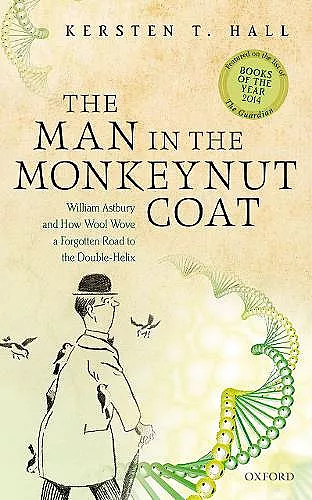The Man in the Monkeynut Coat
William Astbury and How Wool Wove a Forgotten Road to the Double-Helix
Format:Paperback
Publisher:Oxford University Press
Published:2nd Aug '22
Should be back in stock very soon

Sir Isaac Newton once declared that his momentous discoveries were only made thanks to having 'stood on the shoulders of giants'. The same might also be said of the scientists James Watson and Francis Crick. Their discovery of the structure of DNA was, without doubt, one of the biggest scientific landmarks in history and, thanks largely to the success of Watson's best-selling memoir 'The Double Helix', there might seem to be little new to say about this story. But much remains to be said about the particular 'giants' on whose shoulders Watson and Crick stood. Of these, the crystallographer Rosalind Franklin, whose famous X-ray diffraction photograph known as 'Photo 51' provided Watson and Crick with a vital clue, is now well recognised. Far less well known is the physicist William T. Astbury who, working at Leeds in the 1930s on the structure of wool for the local textile industry, pioneered the use of X-ray crystallography to study biological fibres. In so doing, he not only made the very first studies of the structure of DNA culminating in a photo almost identical to Franklin's 'Photo 51', but also founded the new science of 'molecular biology'. Yet whilst Watson and Crick won the Nobel Prize, Astbury has largely been forgotten. The Man in the Monkeynut Coat tells the story of this neglected pioneer, showing not only how it was thanks to him that Watson and Crick were not left empty-handed, but also how his ideas transformed biology leaving a legacy which is still felt today.
Construction of the Watson-Crick model of DNA in the middle of the last century was a key event in scientific history. The surrounding controversies and the larger-than-life players have been widely described but continue to fascinate. By focussing on the lesser known figure of William Astbury, a pioneer in X-ray diffraction studies of biological fibres, this readable account brings a fresh interpretation and new insight. Astbury, widely regarded as a founder of molecular biology, is also shown to have had an understanding of protein structure that was ahead of its time, an understanding that helped create new textiles and a 'monkeynut' coat. * Iain Campbell, Department of Biochemistry, University of Oxford *
This fascinating biography of the founder of molecular biology, the biocrystallographer Willam Astbury, reads like a detective story. Very rich in details, it paints a vivid picture of the scientific scene round Astbury, and reveals some unknown key aspects of the quest for the structure of DNA. * André Authier, Université Pierre et Marie Curie, Paris *
The storyline works very well and I was gripped from the beginning to the end of the book. The author describes numerous stories that capture the human interest aspects of doing science, with its pains and its jubilations. * John R. Helliwell, University of Manchester *
... an excellent, stylish historical account of the early days of biophysics. * The Biologist, Professor Jack Cohen FSB *
Fascinating book. I particularly enjoyed reading about Astbury's background and impressive wide-ranging activities. * Jenifer Glynn, author of My Sister Rosalind Franklin *
Hall''s book provides a useful historical corrective to the notion that all scientists are heroes; some of them are disappointed men. * The Guardian, Stephen Curry *
In The Double Helix, James Watson wrote the Leeds scientist William Astbury out of the story of what, for many, is the greatest biological discovery of the twentieth century. With this superb book, Kersten Hall has written Astbury back in. The result is far more than the biography we have long needed of this colourful and creative pioneer of molecular biology (as Astbury was among the first to call it). In Hall's marvellously readable and deeply researched pages, the development of that science emerges as inseparable from the fortunes of the textiles industry — and from the misfortunes of a man who, like the monkeynut coat he helped to invent, disappeared into obscurity despite huge initial promise. * Gregory Radick, University of Leeds *
...a fine piece of historical writing rich with illuminating detail and with real excitement for the subject. * The British Journal for the History of Science, Kenneth E. Hendrickson *
A very persuasive argument ... I was left in no doubt that Astbury left the scientific world a better and more interesting place. * Rhys Baker, Bio News *
Hall tells his story with style and pace. * Georgina Ferry, Nature *
I have not been disappointed ... beautifully written and easy to read ... a job very well done. * John Jenkin, author of William and Lawrence Bragg, Father and Son: The Most Extraordinary Collaboration in Science *
Very well-written and informative. * Gholson J. Lyon, Cold Spring Harbor Laboratory *
Kersten Hall has brought into the limelight a normally unsung key player in the development of modern molecular and structural biology by writing this very engaging biography of William Astbury. * Elspeth Garman, University of Oxford *
This is an excellent account of molecular biology and Astbury's role in its history. * Anthony C T North, Crystallography News *
- Winner of Shortlisted for the Dingle Prize 2015.
ISBN: 9780198766964
Dimensions: 215mm x 135mm x 140mm
Weight: 366g
272 pages
Revised edition